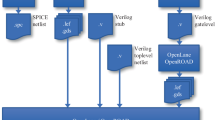Abstract
In this paper, a full analysis is presented on digital-to-analog conversion for pulse amplitude modulated (PAM) systems. By analyzing the cyclostationary nature of pulse-amplitude modulation (PAM) systems, two methods of quantization are proposed –fixed and adaptive. Examples of this quantization analysis are provided for the reverse link transmitter chain in a cdma2000 system, and for the baseband transmitter chain of an IS-136 system. In addition, the impact of D/A converter nonlinearity on resultant signal-to-noise ratio is analyzed. Simulations are provided which show that adaptive quantization provides performance benefits over fixed methods in terms of adjacent channel power rejection (ACPR) and transmitter signal-to-noise ratio.
Similar content being viewed by others
References
W.A. Gardner, Cyclostationarity in Communications and Signal Processing, IEEE Press: New York, 1994.
S. Dennett, The cdma2000 ITU-R RTT Candidate Submission, Ver. 18, The Telecommunications Industry Association, 1998.
M. Nettles, M. Chang, G. McAllister, B. Nise, C. Perisco, K. Sahota and J. Tero, “Analog Baseband Processor for CDMA/FM Portable Cellular Telephones”, in IEEE International Solid-State Circuits Conference 1995, February 1995, pp. 328–329.
G. Mandyam, “Analysis of Impact on Handset Transmitter Design of the High-Speed Data Requirements in the IS-95-B CDMA Wireless Standard”, in IEEE Radio and Wireless Conference, August 1998, pp. 193–196.
TIA/EIA-136, The Telecommunications Industry Association, October 16, 1998.
J. Proakis, Digital Communications, 2nd edn, McGraw-Hill Inc.: New York, 1989.
N.S. Jayant and P. Noll, Digital Coding of Waveforms: Principles and Applications to Speech and Video, Prentice-Hall Inc.: Englewood Cliffs, NJ, 1984.
TIA/EIA/IS-95-A: Mobile Station-Base Station Compatibility Standard for Dual-Mode Wideband Spread Spectrum Cellular System, The Telecommunications Industry Association, 1995.
A.V. Oppenheim and R.W. Schafer, Discrete-Time Signal Processing, Prentice-Hall Inc.: Englewood Cliffs, NJ, 1989.
TIA/EIA-136-131: Digital Traffic Channel Layer 1, The Telecommunications Industry Association, October 16, 1998.
N. Van Bavel, P.C. Maulik, K.S. Albright and X.-M. Gong, “An Analog/Digital Interface for Cellular Telephony”, in IEEE 1994 Custom Integrated Conference, May 1-4, 1994, pp. 395–398.
V. Friedman, K.R. Lakshmikumar, D.L. Price, T.N. Le and J. Kumar, “A Baseband Processor for IS-54 Cellular Telephony”, IEEE Journal of Solid-State Circuits, Vol. 31, No. 5, pp. 646–655, 1996.
W. Struble, F. McGrath, K. Harrington and P. Nagle, “Understanding Linearity in Wireless Communication Amplifiers”, IEEE Journal of Solid-State Circuits, Vol. 32, No. 9, pp. 1310–1318, 1997.
ANSI/J-STD-018: Recommended Minimum Performance Requirements for 1.8 to 2.0 GHz Code Division Multiple Access (CDMA) Personal Stations, American National Standards Institute, 1996.
F. Ling, “Pilot Assisted Coherent DS-CDMA Reverse-Link Communications with Optimal Robust Channel Estimation”, in International Conference on Acoustics, Speech, and Signal Processing 1997, April 21-24, 1997, pp. 263–266.
Author information
Authors and Affiliations
Rights and permissions
About this article
Cite this article
Mandyam, G.D. Digital-to-Analog Conversion of Pulse Amplitude Modulated Systems Using Adaptive Quantization. Wireless Personal Communications 23, 253–281 (2002). https://doi.org/10.1023/A:1021166915751
Issue Date:
DOI: https://doi.org/10.1023/A:1021166915751




